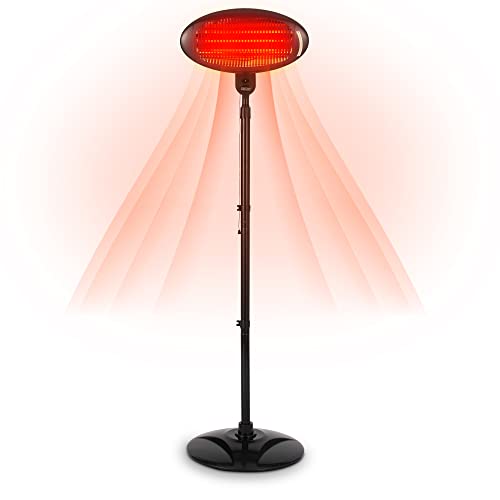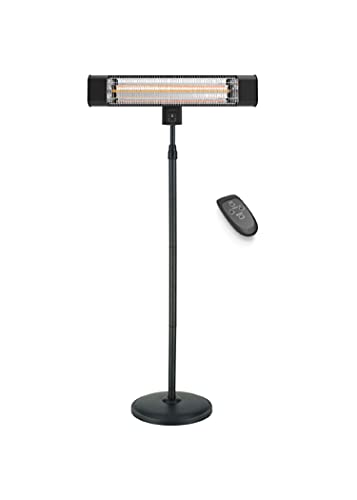Guide To Patio Heat Lamp Electric: The Intermediate Guide Towards Pati…
페이지 정보
작성자 Alysa Grahamsla… 작성일 25-02-02 05:15 조회 20 댓글 0본문
How to Choose a Patio Heat Lamp electric outdoor heaters for patio
When you're looking to heat your patio, there are several options. In contrast to propane models that require refills electric heaters can provide instant heat by flicking the switch or pressing a button.
They also don't emit gasses that could be harmful to health. Some models have adjustable temperature settings for different distances.
Type of Heater
You can relax in your outdoor Patio Heat Lamp Electric living space well into the evening and throughout the year by using the right patio heater. There are a variety of heaters for patios, including freestanding natural gas and propane models as in addition to wall- or ceiling-mounted electric radiant heaters. The choice you make will depend on the dimensions of your patio, existing power sources and personal preference.
 Most patio heater electric heaters use electricity, liquid or natural gas to generate heat. They release heat through a combination convection heating and radiant heating. The heat output of patio heaters is measured in watts, which can be converted into British thermal units (BTUs) to provide a comparison. Certain models come with adjustable temperatures to allow more flexibility.
Most patio heater electric heaters use electricity, liquid or natural gas to generate heat. They release heat through a combination convection heating and radiant heating. The heat output of patio heaters is measured in watts, which can be converted into British thermal units (BTUs) to provide a comparison. Certain models come with adjustable temperatures to allow more flexibility.
A patio heat lamp is an electric burner on a pole with a perforated screen that reflects the flames and radiates the heat downwards to warm furniture, people and other objects. Some models have a reflector above the burner that can be silvered to cut down the amount of heat emitted upwards.
Gas patio heaters are among the most commonly used patio heaters. They are able to heat multiple tables quickly and evenly. These heaters are portable and run off propane tanks or plumbed into your natural gas line, which is greater convenience and lower initial cost of installation, but needing ongoing costs for fuel.
A increasing number of homes are outfitted with natural gas lines, making them the perfect solution for those who prefer to use a gas patio heater. They're easy to set up, but do require a dedicated and functioning gas line to function in a safe manner. There are portable natural gas heaters with extension hoses that can help overcome this restriction however they could be a risk of tripping and also a fire hazard when not in use.
Safety
The majority of electric patio heaters are safe to use in covered areas because they allow heat to radiate outward, instead of upwards towards combustible materials like the roof. However, they're not intended to be used on an open roof; the heater should be set at least 18" from adjacent walls or 6" from the ceiling to avoid fire hazards.
Patio heaters made of propane and gas are usually suitable for use in enclosed areas and are protected by the proper cover specifically designed for use in open air. The covers are typically made of fire-resistant fabrics and have a roof which can be closed. The safety issues with these types of outdoor electric heater patio patio heaters is due to the fumes and flames they emit. They should be kept away from items that ignite, such as chairs and curtains.
When installing a patio heater electric free standing Heat Lamp Electric (Yogicentral.Science) or any kind of patio heater, be sure to follow the manufacturer's directions and safety measures carefully. Make sure you select the one with UL and CSA certifications, and read the owner's guide carefully. Be especially careful when it comes to pets and children, and make sure the heater is not within their reach when it's running. Some patio heaters that are freestanding, such as EUROM, come with a built-in tipping safety that automatically shuts off the heater if it is tipped over.
If your patio heater uses natural gas lines it is essential to inspect the condition of the line regularly and to be tested for leaks by an experienced professional. If the line is in need of replacement get it replaced by an experienced plumbing professional who is licensed. A professional will be in a position to determine if the line should be connected to an underground pipe or not. A professional will also be able to ensure that the heater in the patio is connected to an outlet that is GFCI-rated (ground fault circuit interruptioner) to safeguard against electric shocks and fires.
Installation
The size of the patio heater is positioned determines the amount of heat it can radiate into the space. It is essential that the heater be mounted at an appropriate distance from any surfaces such as plastic which can deform and wood, which can become too hot. You can mount the heater on a wall, structure or any other surface with standard mounting brackets. Certain models have a soft starter that lowers the peak current to protect your circuits.
When you're looking to heat your patio, there are several options. In contrast to propane models that require refills electric heaters can provide instant heat by flicking the switch or pressing a button.
They also don't emit gasses that could be harmful to health. Some models have adjustable temperature settings for different distances.
Type of Heater
You can relax in your outdoor Patio Heat Lamp Electric living space well into the evening and throughout the year by using the right patio heater. There are a variety of heaters for patios, including freestanding natural gas and propane models as in addition to wall- or ceiling-mounted electric radiant heaters. The choice you make will depend on the dimensions of your patio, existing power sources and personal preference.
 Most patio heater electric heaters use electricity, liquid or natural gas to generate heat. They release heat through a combination convection heating and radiant heating. The heat output of patio heaters is measured in watts, which can be converted into British thermal units (BTUs) to provide a comparison. Certain models come with adjustable temperatures to allow more flexibility.
Most patio heater electric heaters use electricity, liquid or natural gas to generate heat. They release heat through a combination convection heating and radiant heating. The heat output of patio heaters is measured in watts, which can be converted into British thermal units (BTUs) to provide a comparison. Certain models come with adjustable temperatures to allow more flexibility.A patio heat lamp is an electric burner on a pole with a perforated screen that reflects the flames and radiates the heat downwards to warm furniture, people and other objects. Some models have a reflector above the burner that can be silvered to cut down the amount of heat emitted upwards.
Gas patio heaters are among the most commonly used patio heaters. They are able to heat multiple tables quickly and evenly. These heaters are portable and run off propane tanks or plumbed into your natural gas line, which is greater convenience and lower initial cost of installation, but needing ongoing costs for fuel.
A increasing number of homes are outfitted with natural gas lines, making them the perfect solution for those who prefer to use a gas patio heater. They're easy to set up, but do require a dedicated and functioning gas line to function in a safe manner. There are portable natural gas heaters with extension hoses that can help overcome this restriction however they could be a risk of tripping and also a fire hazard when not in use.
Safety
The majority of electric patio heaters are safe to use in covered areas because they allow heat to radiate outward, instead of upwards towards combustible materials like the roof. However, they're not intended to be used on an open roof; the heater should be set at least 18" from adjacent walls or 6" from the ceiling to avoid fire hazards.
Patio heaters made of propane and gas are usually suitable for use in enclosed areas and are protected by the proper cover specifically designed for use in open air. The covers are typically made of fire-resistant fabrics and have a roof which can be closed. The safety issues with these types of outdoor electric heater patio patio heaters is due to the fumes and flames they emit. They should be kept away from items that ignite, such as chairs and curtains.
When installing a patio heater electric free standing Heat Lamp Electric (Yogicentral.Science) or any kind of patio heater, be sure to follow the manufacturer's directions and safety measures carefully. Make sure you select the one with UL and CSA certifications, and read the owner's guide carefully. Be especially careful when it comes to pets and children, and make sure the heater is not within their reach when it's running. Some patio heaters that are freestanding, such as EUROM, come with a built-in tipping safety that automatically shuts off the heater if it is tipped over.
If your patio heater uses natural gas lines it is essential to inspect the condition of the line regularly and to be tested for leaks by an experienced professional. If the line is in need of replacement get it replaced by an experienced plumbing professional who is licensed. A professional will be in a position to determine if the line should be connected to an underground pipe or not. A professional will also be able to ensure that the heater in the patio is connected to an outlet that is GFCI-rated (ground fault circuit interruptioner) to safeguard against electric shocks and fires.
Installation
The size of the patio heater is positioned determines the amount of heat it can radiate into the space. It is essential that the heater be mounted at an appropriate distance from any surfaces such as plastic which can deform and wood, which can become too hot. You can mount the heater on a wall, structure or any other surface with standard mounting brackets. Certain models have a soft starter that lowers the peak current to protect your circuits.

댓글목록 0
등록된 댓글이 없습니다.
